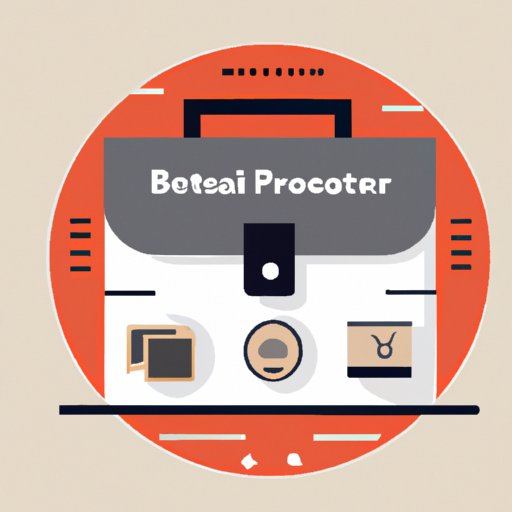Introduction
A business portfolio is a powerful tool for any organization or individual looking to promote their services, products, and credentials. A well-crafted portfolio can showcase your capabilities, experience, and achievements, helping you to stand out from the competition and land more clients and contracts. However, it’s important to create an effective portfolio that accurately reflects your company’s strengths and weaknesses, as well as its unique offering.
In this article, we will explore what to include in a business portfolio, how to analyze your company’s strengths and weaknesses, what types of information should be included, tips for designing and formatting your portfolio, and how to leverage different types of content to create an engaging portfolio that stands out from the rest.

Analyzing the Components of an Effective Business Portfolio
Before diving into creating your portfolio, it’s important to assess your company’s strengths and weaknesses. This will help you determine which elements to include in your portfolio and how to best present them. Take some time to analyze your current offerings, customer base, marketing strategies, and any other relevant factors. Ask yourself questions such as: What makes our company unique? What are our top-selling products/services? What do our clients like about us? What sets us apart from our competitors?
By taking the time to assess your company’s strengths and weaknesses, you can create a portfolio that accurately reflects your brand and effectively communicates your capabilities. Additionally, it’s important to review your current offerings and identify any areas that need improvement. This will help ensure that your portfolio includes the most up-to-date information and presents your company in the best light.
Crafting a Professional Business Portfolio: What to Include and How to Present it
Once you’ve identified the elements to include in your portfolio, it’s time to start crafting a professional presentation. There are several types of information that should be included in your portfolio, such as:
- Company mission statement
- Product/service descriptions
- Client list
- Case studies
- Testimonials
- Awards and recognition
- Product/service samples
- Marketing materials
- Press releases
When designing and formatting your portfolio, there are several tips to keep in mind. First, make sure to use consistent branding throughout your portfolio. This includes using your company logo, colors, and fonts. Additionally, make sure to use clear and concise language and avoid industry jargon. Finally, focus on visuals whenever possible. Utilizing high-quality photos and graphics can help make your portfolio more engaging and easier to understand.

Creating a Customized Company Portfolio – Tips for Maximum Impact
Once you’ve identified the elements to include in your portfolio and created a professional presentation, it’s time to customize your portfolio and differentiate your company from the competition. To do this, you can highlight your company’s unique offerings and showcase your achievements and expertise. Consider including case studies, testimonials, awards and recognition, client lists, and product/service samples.
You can also use social media platforms to increase the visibility of your portfolio and engage with potential customers. Leverage platforms such as Twitter, Facebook, and Instagram to share your portfolio and connect with your target audience. Additionally, consider utilizing visual content such as videos, infographics, and images to showcase your portfolio and make it more engaging.

Essential Elements to Include in Your Business Portfolio
There are several essential elements to include in your business portfolio. These include:
- Case Studies – Case studies are an excellent way to demonstrate your company’s capabilities and show potential customers how you have solved challenges for other clients. Focus on stories that will resonate with your target audience and make sure to highlight the results you achieved.
- Testimonials – Testimonials are a great way to boost your credibility and build trust with potential customers. Include testimonials from satisfied clients that reflect the quality of your work.
- Awards and Recognition – If your company has received any awards or recognition, be sure to include it in your portfolio. This will help demonstrate your commitment to excellence and show potential customers that you are a leader in your industry.
- Client List – Showcase your past and current clients to demonstrate your experience and credibility. Make sure to include recognizable names, if possible.
- Product/Service Samples – Include samples of your products/services to give potential customers an idea of what they can expect from working with your company.
Showcasing Your Business’s Success: How to Build an Engaging Business Portfolio
In order to create an engaging portfolio, it’s important to utilize different types of content. Visual content such as photos, videos, and infographics can help make your portfolio more interesting and easier to understand. Additionally, writing compelling copy is key to engaging your audience and making your portfolio stand out from the rest.
Finally, leveraging social media platforms can help increase the visibility of your portfolio and reach a wider audience. Share your portfolio on platforms such as Twitter, Facebook, and Instagram and use hashtags to reach potential customers.
Conclusion
Creating an effective business portfolio is essential for any organization or individual looking to promote their services, products, and credentials. By assessing your company’s strengths and weaknesses, identifying elements to include in your portfolio, crafting a professional presentation, and utilizing different types of content, you can create an engaging portfolio that stands out from the competition. Essential elements to include in your portfolio include case studies, testimonials, awards and recognition, client lists, and product/service samples.
Creating a business portfolio is an important step towards promoting your company and building trust with potential customers. With the right strategy and a little bit of creativity, you can create a portfolio that showcases your capabilities and helps you stand out from the rest.
(Note: Is this article not meeting your expectations? Do you have knowledge or insights to share? Unlock new opportunities and expand your reach by joining our authors team. Click Registration to join us and share your expertise with our readers.)
